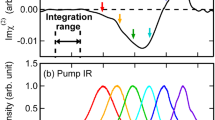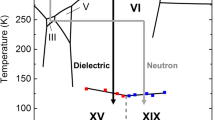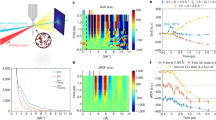Abstract
In H-bonded materials, the frequency of intramolecular vibrations is considered to depend only on the strength of the H-bond, or equivalently, the distance between the H-bonded molecular pairs. Therefore, in vibrational spectroscopic studies of the molecular structure of condensed phases with O–H⋯O bonds, the frequency of O–H stretching vibrations, ν, is generally taken as being directly proportional to the average distance, Ro–o, between the nearest oxygen atoms. Thus (∂ν/∂Ro–o) obtained from a study of various polymorphs of ice (Ro–o range, 2.75–2.83 Å) has been used as a scaling factor to suggest: (1) a continuous random network structure of amorphous solid and liquid water1,2, and (2) the possibility of transformation of ice VII to a structure with centrosymmetric hydrogen bonds3. While such scaling of Ro–o from changes in ν may seem a good approximation, studies of hexagonal ice and ice clathrate suggest that factors other than the intermolecular distances affect the frequency of O–H stretching vibrations. A study of the Raman spectrum of ice clathrate, reported here, shows that in condensed phases where the O–H⋯O bonds are nonlinear and/or the intermolecular distances are distributed over a range (as in water, various amorphous and crystalline forms of ice, ice-like structures, alcohols, carboxylic acids and aqueous solutions), a treatment based on such scaling is an oversimplification; the geometry of the H-bond affects the frequency more than the strength of the H-bond.
This is a preview of subscription content, access via your institution
Access options
Subscribe to this journal
Receive 51 print issues and online access
$199.00 per year
only $3.90 per issue
Buy this article
- Purchase on SpringerLink
- Instant access to full article PDF
Prices may be subject to local taxes which are calculated during checkout
Similar content being viewed by others
References
Sivakumar, T. C., Rice, S. A. & Sceats, M. G. J. chem. Phys. 69, 3468–3476 (1978).
Sceats, M. G., Stavola, M. & Rice, S. A. J. chem. Phys. 70, 3927–3938 (1979); 72, 3260–3262 (1980).
Walrafen, G. E. et al. J. chem. Phys. 77, 2166–2174 (1982).
Johari, G. P. J. chem. Phys. 74, 1326–1336 (1981).
Mak, T. C. W. & McMullan, R. K. J. chem. Phys. 42, 2732–2737 (1965).
Sivakumar, T. C., Chew, H. A. M. & Johari, G. P. Nature 275, 524–525 (1978).
Bertie, J. E. & Jacobs, S. M. J. chem. Phys. 69, 4105–4113 (1978).
Johari, G. P. & Chew, H. A. M. Phil. Mag. (submitted).
Author information
Authors and Affiliations
Rights and permissions
About this article
Cite this article
Johari, G., Chew, H. O–H stretching vibrations in ice clathrate. Nature 303, 604–605 (1983). https://doi.org/10.1038/303604a0
Received:
Accepted:
Issue date:
DOI: https://doi.org/10.1038/303604a0



